Embark On A Journey To Srikalahasti Temple In Andhra Pradesh In 2025
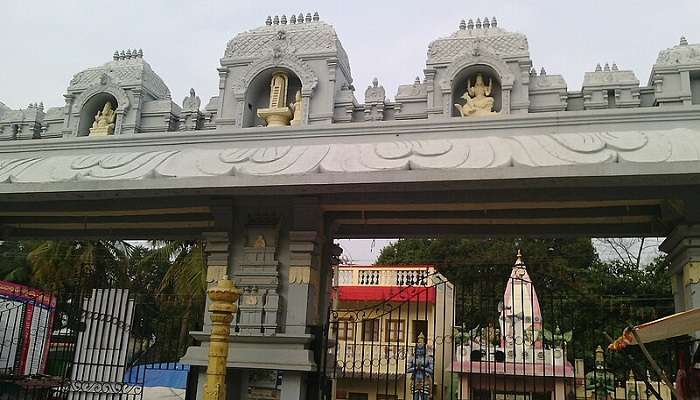
Srikalahasti Temple is an ancient Hindu temple of Lord Shiva situated in Srikalahasti, Chittoor district of Andhra Pradesh, India. Though architecturally magnificent, it has great spiritual significance and attracts pilgrims and tourists from all over the country. It is located on the western bank of the River Swarnamukhi, surrounded by a serene and picturesque landscape. Srikalahasti Temple houses the Vayu Linga, which is one of the Pancha Bhoota Sthalams of Lord Shiva, denoting Vayu. This place is culturally and religiously significant, becoming a hub of devotion and pilgrimage toward the south.
Srikalahasti Temple History
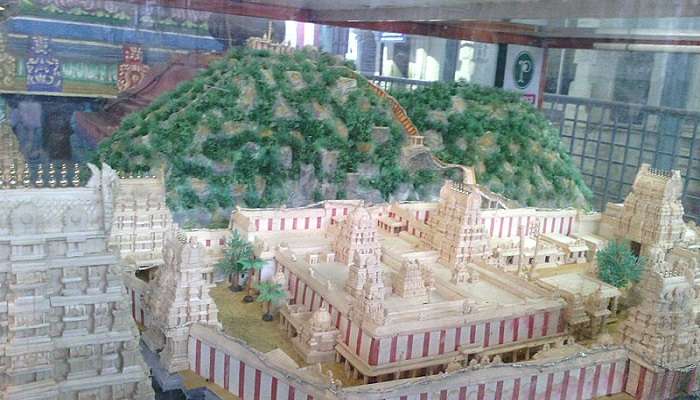
In Srikalahasti and Andhra Pradesh, Srikalahasti Temple is among the most ancient temples in India. The history dates back to over 1000 years. The temple is dedicated to Lord Shiva, enshrined and worshipped as Kalahasteeswara, and is also famous as one of the Pancha Bhoota Sthalams of the Lord, manifesting as air or Vayu. According to legend, the temple’s name comes from three devotees—Sri, Kala, and Hasti—who worshipped a lingam under a snake mound, thus giving it the name Srikalahasti.
It is typical of the loftiness of the traditional South Indian temple style, which is replete with carvings and tall gopurams or gateway towers, along with large courtyards. The present structure has undergone several renovations and expansions over the centuries through the efforts of many dynasties, particularly the Cholas, Pallavas, and Vijayanagara rulers. The temple complex includes many shrines dedicated to Ganesha, Parvati, and Kartikeya, a pointer to its being among the foremost pilgrimage centres of the Shaivites, who are Lord Shiva worshippers.
Also Read: Mogalarajapuram Caves
Architectural Style and Features
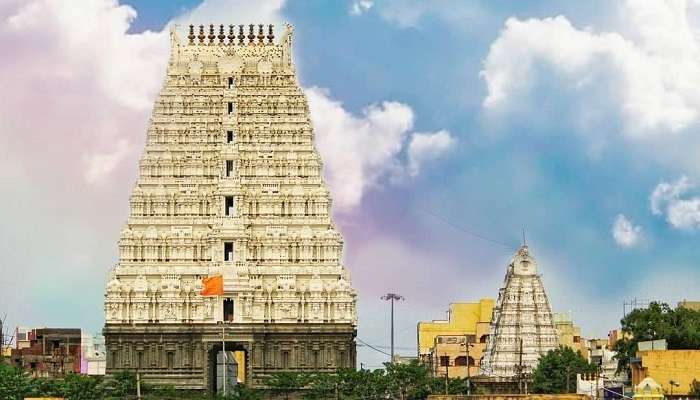
Srikalahasti Temple is typical of the Dravidian style of architecture, reflected in its towering gopurams, fine carvings, and expansive courtyards. Elaborate sculptures of Hindu mythological themes have been engraved at the main entrance, which leads to the spacious outer courtyard of the temple.
This is followed by successive inner courtyards, which gradually open into the main sanctum sanctorum, dedicated to Lord Shiva. The gopurams are embellished with elaborate carvings of gods, goddesses, celestial beings, and mythical creatures—all reflecting the dexterity of ancient Indian artisans.
Structural Layout And Significance
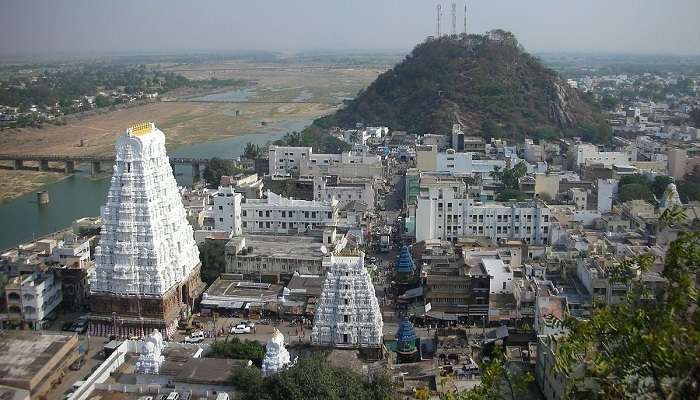
The temple complex strictly includes the sacred tenets that underline Hindu temple architecture. The Vayu Linga is enthroned in the central sanctum, representing air among the Pancha Bhoota Sthalams. These smaller shrines face the main shrine and have many deities, including Ganesha, Parvati, and Kartikeya.
Each of these shrines has different architectural features and spiritual significance. There are mandapams or pillared halls for offerings and rituals, festivals, and cultural programs that add to its functioning as a religious and cultural activity centre in the region. The architectural splendour of the Srikalahasti Temple attracts not only those devotees who come to its doors seeking spiritual solace but also tourists and scholars of South Indian temple art and culture. From its enduring design to historical significance, this place has been, continues to stay, and remains a land stalwart in the cultural tapestry of Andhra Pradesh.
Related Post: Borra Caves
Srikalahasti Temple Timings
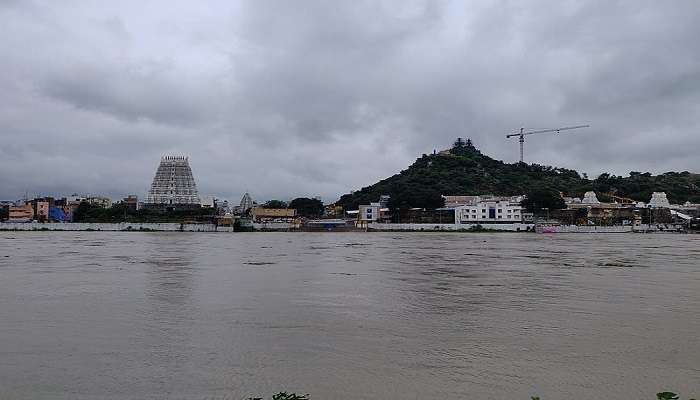
The Srikalahasti Temple functions with resultant timings for darshan and other poojas. Generally, the temple opens early, by 4:30 AM, and remains open the whole day, closing by 9:00 PM. The timings may vary slightly on special occasions and festival days due to increased visits by devotees and religious ceremonies associated with such occasions.
Beginning in the early morning, many poojas/rituals are offered to the deity, namely Abhishekam, ritual bathing of the deity; Archana means worship performed with hymns and sacred chants. Special sevas are performed for Lord Shiva. This old temple is maintained according to age-old traditions and customs so that the visiting atmosphere feels the spiritual atmosphere and cultural section attached to this very ancient shrine. One would also like to note the present timings of the Srikalahasti Temple and any retaining rituals and ceremonies scheduled before visiting them so that one has a worthy experience of worship and spirituality.
Srikalahasti Temple Festivals
There are many festivals celebrated in this temple; we have curated a list of Festivals celebrated in the Srikalahasti Temple:
1. Maha Shivaratri

Maha Shivaratri, the principal and most popular festival concerned with Srikalahasti Temple in this regard, is held with great enthusiasm and religious fervor. Devotees from all directions worship Lord Shiva through the night. Special rituals like Rudrabhishekam, Mahalingabhisheakam, and Sahasra Lingarchana are performed with Vedic hymns and devotional songs. The temple area is coloured with these decorations, while the priests perform inordinately long poojas for Lord Shiva.
Major Attraction: Maha Shivaratri, the principal and most popular festival concerned with Srikalahasti Temple
Point to be noted: Bring along water bottles, as you may have to stand in long lines, especially during peak periods. Be sure to stay properly hydrated, especially during hot weather.
Related Post: Bhupathipalem Reservoir
2. Brahmotsavam
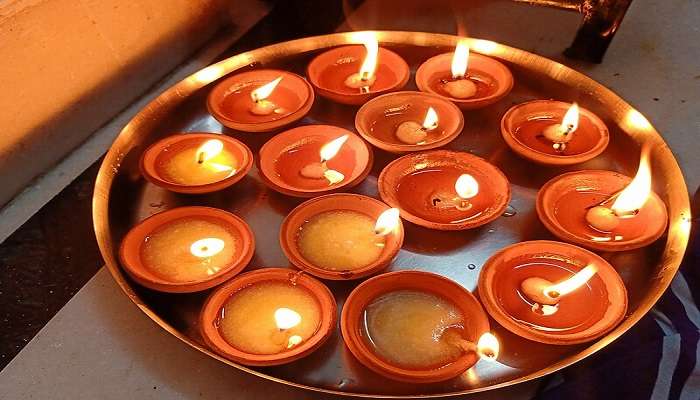
The next important festival celebrated at Srikalahasti Temple is the Brahmotsavam. This is also celebrated for many days, normally in February or March. It comprises the display of the temple flag (Dhwajarohanam) at the commencement and processions of the principal deities mounted on colourfully decorated chariots.
Traditional music and dance add to the festive ambience, attracting big crowds of devotees who participate in rituals and seek divine blessings from the presiding deities.
Major Attraction: This is also celebrated for many days, normally in February or March
Point to be noted: Observe complete silence in some places. Respect the temple customs, such as removing one’s shoes outside and participating candidly in rituals.
You May Also Like To Read: Prakasam Barrage Vijayawada
Be bathed in the divine aura and architectural marvels of Srikalahasti Temple. Whether you seek spiritual solace, cultural enrichment, or want to see its intricate Dravidian architecture, Srikalahasti Temple offers a deep, unforgettable journey. Come join us in celebrating its rich history and vibrant festivals, steeping you through spiritual traditions from ancient India. This is one such opportunity to unfold yourself and visit the premier places of Andhra Pradesh. Plan your trip to Andhra Pradesh today and embark on a transformative pilgrimage to Srikalahasti Temple.
For our editorial codes of conduct and copyright disclaimer, please click here.
Cover Image Credit: Ramachandra for Wikimedia Common
Frequently Asked Questions About Srikalahasti Temple
What is the significance of the Srikalahasti Temple?
Srikalahasti Temple portrays Lord Shiva; it is one of the Pancha Bhoota Sthalam and depicts Vayu, air. It has formidable spiritual and cultural significance for the Lord Shiva devotees
Where is Srikalahasti Temple located?
The Srikalahasti Temple is situated in the town of Srikalahasti in the Chittoor district of Andhra Pradesh, India. It is located on the banks of River Swarnamukhi.
What are the temple timings?
Srikalahasti Temple usually opens early in the morning at 4:30 a.m. and closes by 9:00 p.m. It may vary slightly on festival days and special occasions.
Which festivals are celebrated at Srikalahasti Temple?
The major festivals, such as Maha Shivaratri and Brahmotsavam, are elaborately conducted at this temple with elaborate rituals, processions, and cultural programs. These draw devotees from all over the country.
Is there an entry fee to Srikalahasti Temple?
There is no kind of entrance fee for visiting the Srikalahasti Temple. Devotees and visitors are free to soak in the spiritual atmosphere and architectural splendor of the temple with no fine levied on them.
People Also Read:
Hulimavu Cave Temple Kote Venkataramana Temple Nageshwara Temple

Innovative Content Writer Focused on Producing High quality, Original Content that drives traffic and engages readers. Experienced in Content strategy and analytics to measure content performance using tools such as SQL, Power BI, Excel.











